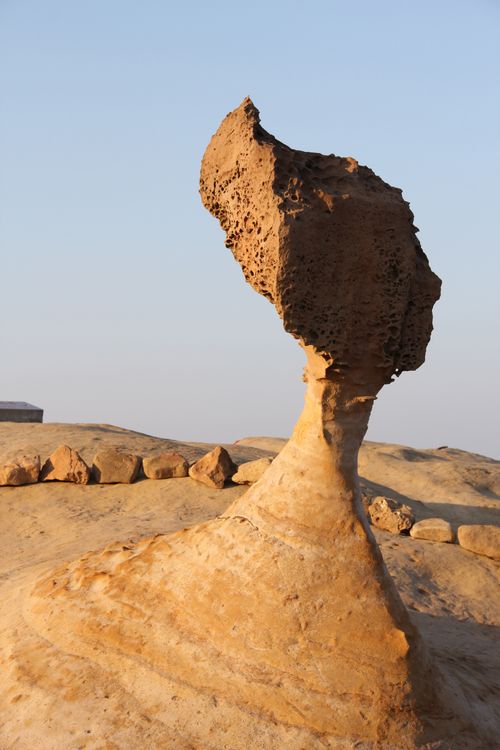As you can see, the Queen’s Head rests on a thin (and getting thinner) neck. This thinning is cause for consternation in Taiwan as a May 25, 2015 news item on the focustaiwan.tv website notes,
The “Queen’s Head,” the most famous rock formation in Yehliu Geopark, faces an uncertain fate despite an all-out effort to prevent its thinning neck from snapping, the North Coast & Guanyinshan National Scenic Area said Monday.
Kuo Chen-ling (郭振陵), the secretary-general of the scenic area administration, said Monday that experiments done on four mushroom rocks near the Queen’s Head have found that nanotechnology can prevent erosion, but it still has some drawbacks that have yet to be overcome.
In the experiments done over the past nine months, nanotechnology has proven that it could reinforce the queen’s neck and delay the weathering process, Kuo said.
But it has also caused the rocks to whiten and slivers of the rocks’ surfaces to break off amid the dramatic changes in temperature, moisture and sunshine on the North Coast, he said.
…
An August 29, 2014 news item on the China Post website gives a description of the attempted remedy,
The Tourism Bureau began preparations Thursday for repairs on the iconic Queen’s Head rock formation at Yehliu Geopark in New Taipei, in a bid to protect the popular tourist attraction from further erosion.
Capitalizing on the sunny weather, which is essential to an experiment on how best to preserve the rock, a group of specialists led by Hsieh Kuo huang, a professor at National Taiwan University’s Institute of Polymer Science and Engineering, injected various nano-sealants into four less-popular rock formations with a similar structure to the Queen’s Head.
The team has coded the rocks A, B, C and D and applied different treatments to them to compare the results.
…
Comprised of nano-sealant mixed with gravel, the remedy can help resist winds up to 250 kilometers per hour and magnitude-7.0 earthquakes, according to the Tourism Bureau.
I’m sorry the first tests were not more successful and I hope they will be able to find a solution in time.
This project reminded me of a European Union (EU) project where they too were attempting to save important stone structures, from my Oct. 21, 2014 posting,
… an Oct. 20, 2014 news item on Nanowerk,
Castles and cathedrals, statues and spires… Europe’s built environment would not be the same without these witnesses of centuries past. But, eventually, even the hardest stone will crumble. EU-funded researchers have developed innovative nanomaterials to improve the preservation of our architectural heritage.
“Our objective,” says Professor Gerald Ziegenbalg of IBZ Salzchemie, “was to find new possibilities to consolidate stone and mortar, especially in historical buildings.” The products available at the time, he adds, didn’t meet the full range of requirements, and some could actually damage the artefacts they were meant to preserve. Alternatives compatible with the original materials were needed.
For those interested in more, there are details about the EU project the product, CaLoSil, that the scientists devised, and links to more resources in my post.
